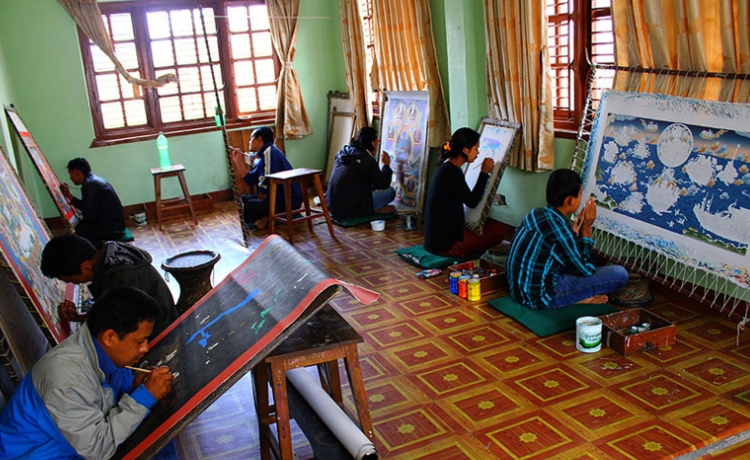Thangka Painting in Nepal

Published Date :10 Jan, 2016
Thangka is a Tibetan term that has two syllables ‘Thang’ which means ‘A plain surface’ and ‘Ka’ means ‘an image’. So, Thangka literally means ‘Image on plain surface’. So, this artwork is a divine portrait. In fact, Thangka Painting is a religious artwork illustrating the sacred events and message in a specially treated cotton cloth.Thangka Painting has developed over centuries, shaped and influenced by religious traditions. The paintings are based on the various aspects of mind that consist of our thoughts, emotions, afflictions, and wisdom underlying within every one of us. Psychological aspects have been personified in Thangkas.
Nepal, the birth place of Buddha is famous for this art. This has been used as a visual means of disseminating various aspects of Buddha’s teaching and the different events and deeds of Buddha. For example, in the painting of ‘Buddha’s Life’, there is a narrative painting which narrates the account of Buddha’s life story from his decent from the Tushita heaven through his birth, his princely life, his renunciation of the palace, his enlightenment, acts of dissemination of his teaching to his Mahaparinirvana. Likewise, the wheel of life is a detailed representation of basic Tibetan belief i.e. the trans-migratory existence. The Mandala is a Tantric meditation device, a visual aid for concentration and introvert meditation leading to the attainment of insight and also for activation of forces culminating in “Siddhi” supernatural forces.
Thangkas are not kept on frame and rolled up when they are not on display. Thangkas should be kept in dry places so that they can last long but they are of delicate nature. Most Thangkas are intended for personal meditation or instruction of monastic students. Thangkas serve as important tools depicting the life of Buddha, other deities, bodhisattvas etc. Thangkas perform several functions like teaching tools depicting the life of Buddha, describing historical events concerning important Lamas, retelling myths etc.
Thangkas are painted on cotton or silk. The most common is loosely woven cotton produced in width from 40 to 58 centimeters (16-23 inches). They have seam in the support. The paints consist of pigments in water-soluble glue. The composition of a Thangka with the majority of Buddhist art is highly geometric. Different parts of the body and various ritual implements are all laid out on a systematic grid of angles and intersecting lines. Thangka often overflow with symbolism and allusion. The work must be in accordance with strict guidelines laid out in Buddhist scripture. The artist must be properly trained and have sufficiently religious understanding, knowledge and background to create an accurate and appropriate Thangka.
Thangka painting in Nepal dates back to about 14th century AD probably after Buddhists and Hindus began to make illustrations of deities and natural scenes. One of the earliest specimens of Nepalese Thangka painting is Amitabha surrounded by bodhisattvas.
Thanka painting's lining and measurement, costumes, implementations and ornaments are mostly based on Indian styles. The drawing of figures is based on Nepalese style and the background scenery are based on Chinese style. Thus, the Thangka paintings became a unique and distinctive art. Although the practice of Thangka painting was originally done as a way of gaining merit it has nowadays evolved into a commercial business and the noble intentions it once carried has been diluted. Tibetans do not sell Thangkas on a large scale as the selling of religious artifacts such as Thangkas and idols is frowned upon in the Tibetan community and thus non Tibetan groups have been able to monopolize on its (Thangka's) popularity among Buddhist and art enthusiasts from the west.
Thangkas have developed in the northern Himalayan regions among the Lamas. Besides Lamas, Gurung, and Tamang communities are also producing Thangkas, which provide substantial employment opportunities for many people in the hills. Newari Thangkas or Paubha have been produced in Kathmandu valley from the 13th century.
Related Blog(s)
- Experiencing Free Walking Tour Kathmandu with Shiva Dhakal
- Trekking en Poonhill
- Nagarkot to Changunarayan Hiking
- 5 must-see places in Kathmandu
- 5 tips for your first trek in Nepal
- Free Walking Tour Kathmandu
- Nagarkot Changunarayan Hiking
- Champa Devi Hiking
- Bandipur Village Tour
- Tips: before you trek to Nepal
- Langtang Trekking Review
- Poonhill Trekking Review
- Ghorepani Poonhill and Village Tour in Nepal
- Village Tour in Nepal : Gorkha
- Osho Tapoban Review - A Secluded Spiritual Getaway from Kathmandu
- Dakshinkali Pharping - A Local Experience!
- Pupal Yarsha Festival - 2016
- Lacs Gokyo et camps de base de l'everest avec Himkala Adventure
- Hiking in Nepal
- Singing Bowl in Nepal
- Rudraksha (Utrasum), Ammonite Fossil (Shaligram), Spatika (Quartz) in Nepal
- Pashmina in Nepal
- Gorkha-The Historical Place
- Shopping in Nepal with Himkala Adventure
- Trekking in Nepal with Himkala Adventure
- Garden of Dreams:The Garden of Six Seasons
- Pokhara: An Enchanting City
- Nepal: Beautiful Country in the World
- Bhaktapur: The City of Artistic Treasure
- World Tourism Day 2015




